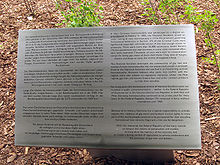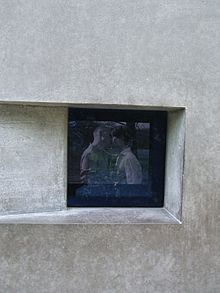- Memorial to Homosexuals persecuted under Nazism
-
The Memorial to Homosexuals persecuted under Nazism in Berlin was opened on 27 May 2008.[1]
Contents
Design of memorial
The Memorial was designed by artists Michael Elmgreen and Ingar Dragset.
The Cuboid is made of concrete. On the front side of the cuboid is a window, through which visitors can see a short film of two kissing men. The work is the third of its kind in Germany following Frankfurter Engel (1994) in Frankfurt and Kölner Rosa Winkel (1995) in Cologne.
The memorial was discussed by all parties in the Bundestag, which granted permission in 2003.[2]
Near the memorial is a signboard, which is written in German and English. There visitors can read over persecutions during Nazism and under Paragraph 175, the law during 1950s and 1960s that outlawed homosexuality. It was reformed in 1969 and fully repealed in 1973.
History of memorial
The homosexual victims of Nazism were not officially recognized after 1945. During 1950s and 1960s, Paragraph 175 was still part of the German penal code. In the 1980s, these "forgotten victims" were finally discussed. In 1985, for instance, president Richard von Weizsäcker remembered homosexuals as a "victim group". The group Der homosexuellen NS-Opfer gedenken and the organization Lesben- und Schwulenverband began promoting a memorial in Berlin in 1993. [3]
On 2003, 12 December, the Bundestag approved erecting a memorial in Berlin at the boundary of Tiergarten (near to Memorial to the Murdered Jews of Europe). Then the competition for artists started.
Politicians attending the 27 May 2008 dedication included Berlin's Mayor Klaus Wowereit, President of the Bundestag Wolfgang Thierse, German Culture Minister Bernd Neumann, Volker Beck and Renate Künast. Mayor Wowereit held the opening speech for the memorial. Following its dedication, it was frequently vandalized that year.[4][5]
Discussion
After the competition for an artist, which Michael Elmgreen and Ingar Dragset won, a discussion was held regarding the video, specifically whether to include lesbians kissing. Lesbians victimized under Nazism have not been documented, though there are instances recorded of lesbian pubs in cities like Berlin which were lost. The feminist magazine EMMA protested that the memorial should also be to persecuted lesbian people. As result of the discussion, the video will be changed every two years and will also show kissing lesbians.[6]
Literature
- Rüdiger Lautmann. Nationalsozialistischer Terror gegen Homosexuelle. Verdrängt und ungesühnt. (together with Burkhard Jellonnek): Paderborn: Schöningh. 2002. ISBN 3-50674-204-3
See also
- History of gay men in Nazi Germany and the Holocaust
- Homomonument
- Memorial to gay and lesbian victims of National Socialism
- Pink triangle
References
- ^ BBC:Berlin remembers persecuted gays
- ^ Discussion in Bundestag
- ^ Gedenkort
- ^ "Berlin gay Holocaust memorial vandalized", QX. August 30, 2008. Accessed June 13, 2011
- ^ "Vandals Hit Berlin's Gay Holocaust Memorial a Second Time", Towel Road. December 16, 2008. Accessed June 13, 2011
- ^ Bundesregierung: Kulturstaatsminister Bernd Neumann erzielt Einigung beim Denkmal für die im Nationalsozialismus verfolgten Homosexuellen
External links
- Memorial for homosexual people tracked under Nazism (German)
- Gedenkort (German)
- Rosa Winkel (German)
- Article by LSVD (German)
- BBC: Berlin remembers persecuted homosexuals
Coordinates: 52°30′47.71″N 13°22′34.74″E / 52.5132528°N 13.3763167°E
Categories:- 2008 establishments
- Monuments and memorials in Germany
- Buildings and structures in Berlin
- Berlin culture
- Holocaust museums
- LGBT history of Germany
- Persecution of homosexuals in Nazi Germany and the Holocaust
Wikimedia Foundation. 2010.




